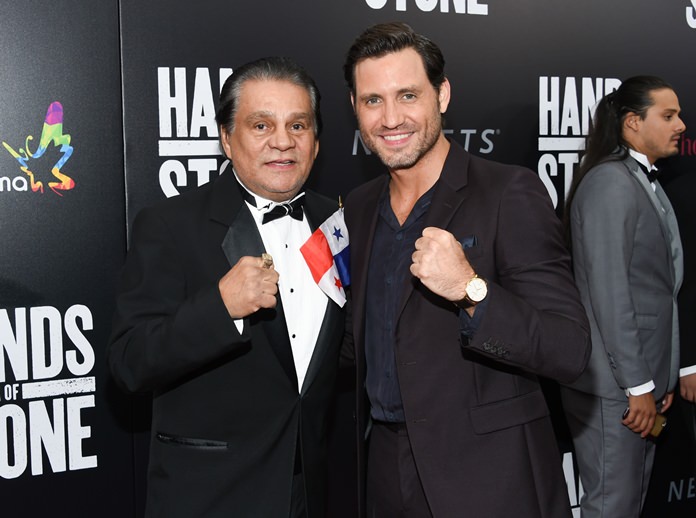New York (AP) – From a building in Manhattan’s midtown, Roberto Duran and Edgar Ramirez can see Madison Square Garden.

“The Garden, many good memories,” says the Panamanian about the New York arena where he won two world titles: the first of his successful career in 1972 and his third in 1983.
At 65, Duran’s energetic personality remains intact, telling anecdotes and making jokes just as he used to do at the height of his career as a bruising, head-on boxer.
Ramirez, 39, is impressed by the physique of the man he portrays in “Hands of Stone,” a film that bears the nickname of the athlete who fought 119 bouts in five decades.
“Roberto, you’re lean, you’re in shape,” says the Venezuelan actor. Duran is happy with a regime that has helped him stay fit and new fitness equipment he just acquired.
Filmed in Panama and New York, the movie by Venezuelan writer-director Jonathan Jakubowicz tells the story of a boxer that emerges from extreme poverty to reach fame and fortune. It shows the rivalry between Duran and Sugar Ray Leonard, portrayed by Usher, including their two bouts for the welter title in 1980.
Thirty five years after starring as Jake LaMotta in Martin Scorsese’s “Raging Bull,” Robert De Niro plays Ray Arcel, Duran’s septuagenarian trainer. And Panamanian actor and salsa star Ruben Blades plays Carlos Eleta, Duran’s manager.
For “Hands of Stone,” Duran served as a mentor to Ramirez, a boxing novice when he was offered the part. The star of “Carlos” and the newer “Point Break” wanted to learn how to fight.
“I had never boxed before, I knew nothing about this. I moved to Panama to start the process and Roberto and his children looked after me, they were my first trainers,” Ramirez said in a recent interview. “It is a very intimate, warm movie. In the end, we all became good friends and we still are. To me, it was very important to learn how to fight, to understand boxing from my own point of view, before going into Roberto’s skin.”
For Duran and Ramirez, this is not just another boxing movie.
“Boxing is always in fashion, you can always talk about boxing,” says the champion.
And although “Hands of Stone” sticks to the conventions of this kind of movie — a boxer goes rags-to-riches, reaches stardom, falls and finally redeems himself — Ramirez and Duran believe that the story engages the viewer by showing the psychological aspects of the sport.
“We are not only talking about boxing. We are talking about this person’s life,” Duran said in the interview. “It’s about how you got to the top. The hunger you suffered, the sacrifices that you made. The thefts, … The friends that I call ‘the bloodsuckers,’ those that exploit you and rob you.”
There is a moving scene when Arcel, working Duran’s corner, wipes the hair from the boxer’s face in a fatherly gesture. The reason, Duran said, was that his long hair prevented him from seeing his opponent’s punches, but at the same time it served as a ruse.
“It had to do with the strategy,” Ramirez said. “Every time, when he returned to fighting after each round. And if his hair was combed this obviously gave the opponent a sense of vulnerability.”
“When we think about boxing movies, many people classify them as sports movies, but this is a drama. It is a film that talks about how you win and how you lose in your head,” the actor added.
The film is being promoted as the “biggest” Latin American production. Except for the fights choreographer and the costumes designer, the rest of the crew is Latin American.
This is the third real life character Ramirez has portrayed, after terrorist Ilich Ramirez Sanchez “El Chacal” in Olivier Assayas’ “Carlos” and Simon Bolivar in “The Liberator.”
“I’ve had the fortune of coming across wonderful characters like Roberto Duran,” Ramirez said. “What caught my attention is that he’s more than an athlete. Beyond his victories and his titles, it’s what he represents in terms of identity to Panama and to Latin America and how Roberto has been accompanied in his greatest and most important moments, unifying, consolidating, binding together the identity of a country. Those themes are also present in this movie.”
“Every time Roberto climbed into the ring, he was not fighting alone against an opponent; he had a whole country backing him, supporting him.”




